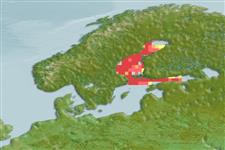Teleostei (teleosts) >
Salmoniformes (Salmons) >
Salmonidae (Salmonids) > Coregoninae
Etymology: Coregonus: Greek, kore = pupils of the eye + Greek, gonia = angle (Ref. 45335).
More on author: Linnaeus.
Environment: milieu / climate zone / depth range / distribution range
Ecology
Marine; freshwater; brackish; benthopelagic; anadromous (Ref. 51243); depth range 30 - ? m. Temperate; 66°N - 59°N, 16°E - 31°E
Europe: Baltic basin, lakes of upper Volga drainage (Seliger, Vseluga, Perejaslavskoe), some lakes of White sea basin and North Sea basin east of Elbe drainage. Anadromous in Gulf of Finland and marine in northernmost freshened part of Gulf of Bothnia; north to about 69° N in Lake Inari, northern Finland; lower Rhine (now extirpated). Frequently stocked in lakes and reservoirs in Germany and Poland.
Size / Weight / Age
Maturity: Lm ? range ? - ? cm
Max length : 48.0 cm TL male/unsexed; (Ref. 556); common length : 20.0 cm TL male/unsexed; (Ref. 556); max. published weight: 1.0 kg (Ref. 556); max. reported age: 10 years (Ref. 593)
Lacustrine and marine in open water. At sea, forages close to coast (Ref. 59043). Forms pelagic schools in deeper lakes (Ref. 4779). Spawns along shores, at 3-10 m depth, rarely to 22 m depth or just below surface. Spawns deeper in clear lakes and closer to surface in lakes with humic waters (Ref. 59043). Spawns on shallow sand or gravel substrate. Anadromous in the Baltic. Feeds on planktonic crustaceans (Ref. 4779).
Ascend a short distance up the rivers in shoals in late August to mid-October. Mature in the second year (lacustrine forms later) and the young ones descend in late summer (Ref. 4779).
Svetovidov, A.N., 1984. Salmonidae. p. 373-385. In P.J.P. Whitehead, M.-L. Bauchot, J.-C. Hureau, J. Nielsen and E. Tortonese (eds.) Fishes of the north-eastern Atlantic and the Mediterranean. UNESCO, Paris. vol. 1. (Ref. 4779)
IUCN Red List Status (Ref. 130435)
Threat to humans
Harmless
Human uses
Fisheries: commercial; aquaculture: experimental
Tools
Special reports
Download XML
Internet sources
Estimates based on models
Preferred temperature (Ref.
123201): 2.1 - 4.5, mean 2.6 °C (based on 38 cells).
Phylogenetic diversity index (Ref.
82804): PD
50 = 0.5000 [Uniqueness, from 0.5 = low to 2.0 = high].
Bayesian length-weight: a=0.00468 (0.00388 - 0.00563), b=3.21 (3.17 - 3.25), in cm total length, based on LWR estimates for this species (Ref.
93245).
Trophic level (Ref.
69278): 3.1 ±0.17 se; based on food items.
Resilience (Ref.
120179): Medium, minimum population doubling time 1.4 - 4.4 years (K=0.3-0.7; tm=2; tmax=10; Fec=2,000).
Fishing Vulnerability (Ref.
59153): Moderate vulnerability (35 of 100).
Climate Vulnerability (Ref.
125649): High vulnerability (62 of 100).
Nutrients (Ref.
124155): Calcium = 21.4 [13.3, 39.0] mg/100g; Iron = 0.364 [0.260, 0.521] mg/100g; Protein = 17.7 [16.5, 18.8] %; Omega3 = 1.12 [0.49, 2.91] g/100g; Selenium = 17.9 [8.0, 39.0] μg/100g; VitaminA = 13.8 [5.2, 36.5] μg/100g; Zinc = 0.609 [0.504, 0.716] mg/100g (wet weight); based on
nutrient studies.
